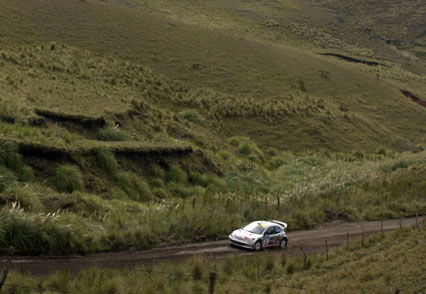80 cars to compete in new starting system.
Up to 80 cars will be permitted to compete in Australia's round of the 2001 FIA World Rally Championship - the Perth-based Telstra Rally Australia.
In announcing the opening of entries, Clerk of Course Garry Connelly said that whilst he understood that some potential crews might miss out on a drive in Australia's most prestigious rally, the realities of the modern world championship meant that entries must be restricted to 80 vehicles.
"The entry cap means the competition will be more professional, and more exciting for spectators and television viewers," said Mr Connelly.

Up to 80 cars will be permitted to compete in Australia's round of the 2001 FIA World Rally Championship - the Perth-based Telstra Rally Australia.
In announcing the opening of entries, Clerk of Course Garry Connelly said that whilst he understood that some potential crews might miss out on a drive in Australia's most prestigious rally, the realities of the modern world championship meant that entries must be restricted to 80 vehicles.
"The entry cap means the competition will be more professional, and more exciting for spectators and television viewers," said Mr Connelly.
"With the evolution of modern timing and sophisticated tracking systems, its also impossible to accommodate as many vehicles as previous rallies. There's also enormous pressure on resources because of the success of the championship in attracting major teams. These teams require more space in Service Parks, as well as more infrastructure and event administration."
"Last year, a record 17 factory-backed cars entered the event and in 2001 we're expecting the field to be even more impressive. The ultimate winners will be spectators and television viewers, as this top quality field guarantees a thrilling sporting contest," Connelly added.
Cars going over this year's start ramp will also take part in a new starting order system. The new system is based on a refined version of the 1999 scheme that was almost universally praised.
Historically methods for each leg of a world rally event have cars starting in the order they finished in the previous day's leg. This can put the lead cars at a distinct disadvantage, especially on the extremely slippery gravel roads in Western Australia. In essence, they become little more than sweep cars, clearing away the stones for the remaining vehicles.
Arrangements for this year's Telstra Rally Australia allow the first priority drivers to choose their road position for the next day's contest.
For the first stage (SS1 at Langley Park) cars will start in reverse order with three-minute intervals between each pairing. Then, for the first full day of leg one, the driver leading the world championship will be given the first opportunity to select his road position, followed by the second ranked driver and so on.
At the end of legs one and two priority one drivers may select any position between one and the number of priority drivers remaining in the event. They will make their selection in order of where they're currently placed in the overall results of Telstra Rally Australia.
The remainder of the field will start each leg in order of classification. Connelly believes the new system will avoid the confusing tactics employed last year by drivers attempting to artificially position themselves in the right spot on the road.
"Given that driving as fast as possible all the way is what rallying is about, we believe the change will deliver the best event for drivers, teams and spectators," he said.
"The proposed system was adopted by the World Rally Commission on a trial basis. And, whilst it may need some additional refining, its anticipated that it will be used as a template by other world championship events in the future."
Supplementary Regulations and entry forms for the 2001 Telstra Rally Australia - to be run from 1-4 November - are available on the event's website www.rallyaustralia.com.
In order to provide an equitable system for determining which entries should be accepted, Telstra Rally Australia will firstly examine the entrant's commitment to the World Championship, the World Teams Cups, the World Group N Championship or any other title.
Included in these criteria will be competitors contesting the Australian Manufacturers Championship and the Tasman Cup.
The organisers will then consider an entrant's previous support of Telstra Rally Australia, their commitment to the Australian Rally Championship, or to a CAMS state-based championship or series. A small number of promotional entries will also be permitted to compete in this year's rally.
